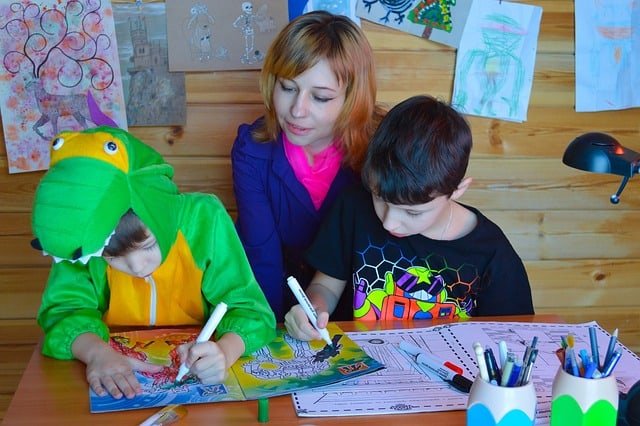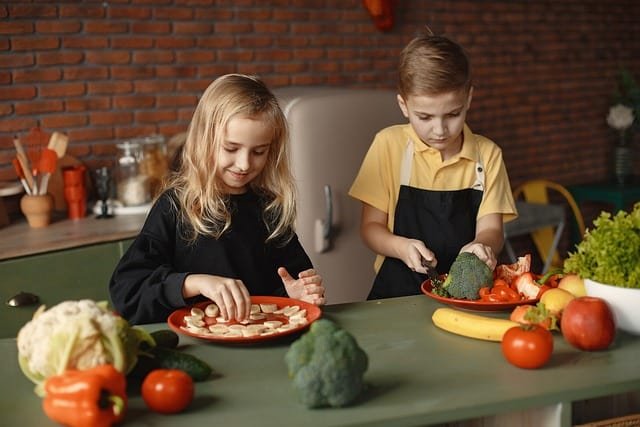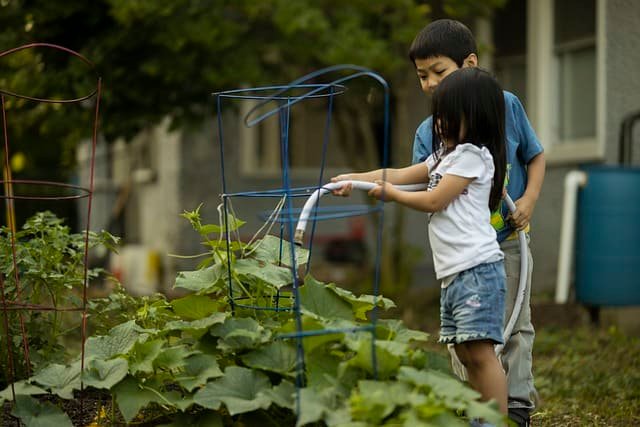Thanks to break-neck pace of development in AI (Artificial Intelligence), many parents today wish they knew the secret to equip their child for the new era. Their anxiety is indeed justified, as by 2030, a vast majority of all mundane, repetitive and highly labour intensive jobs around the world will be taken over by robots – whose functioning will be backed by AI.
As a parent yourself, the question that’s been probably already dominating your mind for a while now could be: “How do I empower my child to deal with, adapt to and thrive during and after this already-happening unprecedented change?”
Well, the answer is simple. You have to invest some of your time and effort to improve creative intelligence quotient in your child on an ongoing basis, especially during early childhood.
Table of Contents
Before we get look into each of the 10 ways to improve creative intelligence, let us dwell a bit on what is creative intelligence.
What is Creative Intelligence?
Creative Intelligence is the ability to invent unique solutions to new problems. It often requires thinking in very unusual ways on your own, and sometimes in collaboration with others.
In the domain of psychology, creative intelligence is the ability to solve problems by imagining radically new, innovative and unique solutions.
Creative Intelligence is also called Experiential Intelligence, as it often involves intellectual flexibility and innovativeness, in situations that are very unique and/or unexpected. The degree to which one can be intellectually flexible and innovative is largely dependent on one’s life experiences, and therefore the name Experiential Intelligence.
Just Think Children
When you think of creative intelligence, just think children. Because unlike adults, they can do creative things in a snap, which we can’t even imagine doing, even if given time. They are always curious for answers and solutions, which makes them naturally creative. That’s why it can be said with no second thoughts, that children are basically synonyms of creative intelligence.
For instance, when your child is in bed, just try asking “What shall we do to make the ceiling look interesting and fun?” All you need to do is only ask, and be amazed by the train of ideas that flows your way from your adorable little one!
They Are Like Water
Children are like water. They are almost always in a flow, and take their own course. There’s no stopping them when they are in a flow. Their curiosity to know about things is like the giant river that cut through the rocks and crate canyons (just look up how the Grand Canyon was created).
That’s why it is important that you do everything within your capacity to retain that creative spark them. A spark that is raw, original, pure and unadulterated. It’s almost like nothing could be more authentic and beautiful.
It is this rawness and purity that makes them and keeps them unique – provided you let them be. They also bring success to them through various avenues in the long run gives them the creative advantage.
As a parent, all you need to do is facilitate your child to increase creative intelligence, especially the dominant ones that are specific to your child.
The Many Intelligences
For a long time, intelligence was thought of only as Intelligence Quotient or IQ. But it was only during the early 80s when an American developmental psychologist by name Howard Gardener developed the Theory of Multiple Intelligences and how to identify them.

Thanks to Gardner, we today know that each child is born with eight different intelligences, among which a few will naturally be dominant ones.
Gardner goes on to add that as a parent, it becomes your responsibility to see that you foster, on an ongoing basis, the other relatively less dominant intelligences too that your child possesses.
To get the right answers, one should ask the right questions. That’s why every parent should ask themselves questions like:
“How can I know and understand which are my child’s dominant intelligences?”
“How can I help my child become an expert at the dominant ones?”
“How do I encourage my child improve on the less dominant ones?”
Here are few ways to increase creative intelligence quotient in your child.
1. Help Children Play on Their Strength
When it comes to intelligence, unfortunately, a vast majority of parents think only of scholastic performance and accomplishments. However, to increase creative intelligence in your child, you have to look beyond and outside the world of academics.
Why? Well, we are well into the third decade of the 21st century, and we have been through a global event in 2020 & 2021 (we are still kind of at the tail end of it) that changed the world in many ways. One of the outcomes of the post global event, is that we now live in a world where scoring marks and academic credentials may still hold a place, but not the way it did before 2020.
We are living in changed times now, when many if not most parents are slowly realising that performing well only in the sphere of academics cannot really create a future for their child, let alone guarantee it.
In other words, it is up to the child to create his/her own future, for which it is important that they are able to provide value through their own inherent talent, along with the abilities and skills they have been developing, are still developing, and will be developing – over the years.
They are entering into what can be termed as a high-octane technology and digital era, where robots will do most of the work far quickly, efficiently, consistently, and of quality – 24 hours a day, 7 days a week and 365 days a year. And that is something the generation of the mid-90s and earlier should really sink in.
Therefore, if you want your child to relevant in such kind of world of the 2030s and beyond (whose seeds have already been sown), then they have to be far more competent – creatively. And this can happen only if they play on their original and inherent strengths.
Observation is Key
As a parent, you need to identify the intelligence that is already there in your child. For example, you may find your child good at grasping the rhythm of beats in music, or match their taps with their hands, fingers or feet to their favourite song. This is an indication of what is called as Body or Kinesthetic Intelligence, which is one among the eight multiple intelligences as theorised by Howard Gardner.
Your observation skills are therefore key when it comes to helping your child to play on his or her strengths. Chances are, you may see your child being good a numbers but demonstrates far more enthusiasm and inclination towards arts. This may manifest in many forms like pencil sketching, crayon colouring, water colouring or oil painting, among others.
Some parents may see their child being good at language and using words, finishing puzzles fast, dancing or getting along well with others while playing team sports. All these are different aspects of intelligence.
2. Provide Them with the Right Environment
The proof of creative intelligence in children lies in the fact that they come with a natural ability to process and demonstrate their skills, talents and abilities in their own unique ways. But for them to be expressive, they need to be in an environment/surrounding which not only allows them to just be themselves, but also express themselves – freely.
Children just love he freedom to express themselves – dozens of times over compared to adults! That’s why, be it at home or in school home, the importance of the indoor learning environment can’t be emphasised enough. This means you need to provide enough space that they feel comfortable in, along with the tools required for learning; such that they get adequate opportunities to freely express their creative dimension.
3. Ask Them Questions
Asking your child simple questions like:

“Why are the stars visible only in the night?”
(by the way, when was the last time you star-gazed with your child?)
“Why is the bark of this tree very different from that one?”
Such questions help spark their curiosity about how nature works.
Similarly, you can ask questions like:
“What is 2 plus 2?”
“What do you think are the other ways 4 can be arrived?”
(like 1+3, 3+1, 2×2, 5-1, etc.)
Asking such questions triggers their thought process, which in turn makes them understand that the same result can be arrived using different permutations and combinations, and through various approaches. And as they grow and go about their daily life, this awareness and understanding will make them see things from different perspectives without even trying much.
4. Encourage Them to Indulge in Art
One of the most valuable and rewarding things you can do as a parent, is to encourage them to spend time in and indulge with any of the art forms.
Arts have been classified into seven kinds:

i) Painting: Oil painting or water colours, and even sketching; be it pencil sketching or with crayons.
ii) Architecture: Just give them building blocks, and they will do the rest.
iii) Sculpting: Your child can try a hand at sculpting even with a piece of moist dough.
iv) Literature: Reading story books, especially picture story books.
v) Music: It can be playing musical instruments or even listening to music (covered in detail below).
vi) Performing Arts: Dance, music, magic, spoken word and puppetry are some of the things your child can try performing.
vii) Cinema: Watching good movies, selectively, especially cartoon and animation movies (watch the original version of “The Lion King” and explain what Simba’s father actually means when he says “You are more than what you have become.”)
If there is any weekend workshop being conducted in painting or pottery, enroll them. Be with them when they are learning pottery hands-on. Appreciate their work, and also appreciate other children’s work too. This will make them learn how to appreciate others’ talents too.
If you are enrolling yourself for painting classes, enroll them too. Paint with your child and enjoy each other’s work. When they see you try something interesting, they will try too.
5. Watch Sports & Games With Your Child
A very interesting and powerful thing you can do improve creative intelligence is to take your children to watch their favourite sport live in a stadium. When kids watch any sport (let alone their favourite sport) in a stadium along with thousands if not tens of thousands of people cheering for their favourite team, it can open up their minds like very few other experiences can.
And no, you don’t have to go for box seats tickets for giving a good experience. Yes. It’s good to have them, but you don’t have to have them. Think of the first time you had been to the stadium. How did you feel?

Was it just about the game and the players?
Or was it about the ambience, energy and community experience?
So you now know what we’re talking about. Right?
When kids watch a sport live in stadium, they also understand aspects beyond the game better, things like what it means for players to perform in front of thousands of people, and that they have to take the appreciative cheers and deal with the discouraging booing too; which are lessons whose depth and width can’t be really felt or understood while watching it from a couch on any fancy TV.
While watching the sport, don’t just be a spectator and focus only on the scores. While the game is on, ask questions like:
“Do you play the same way they are playing?”
“Yesterday when you were playing, did you hit/kick the ball the same way he/she just did?”
“Wow! He caught the ball the same way you did in school, right?”
Or say things like:
“Look how fast he’s running, just like the way you did in school during sports day.”
Asking questions and making statements like these can help your child have conversations with you, and it is up to you to take it to the next level and make it a rich conversation.
6. Indulge Them in Rich Conversations
Every family should take conscious efforts to provide children an environment which is rich in conversations. This means when the child is in the midst of adults, they should hear adults taking about different if not diverse subjects, as it would give them different perspectives about different topics.
Children learn what they see!
It therefore becomes critical that as a parent, you speak and do only that what you want your child to learn; something which you will be proud of now, and your child will be proud of much later in life as an adult.
Unfortunately, most of the adults today are almost always talking about topics that revolve around “Breaking News”, which has got absolutely nothing to do with children. What is worse is that they keep watching over, and over, and over, therefore talking about it like a marathon. In the process, poor kids find themselves kind of left alone in an ‘island’ with people around, but no one to talk what they want to listen to.
What are Rich Conversations?

Any conversation with an adult that triggers children’s curiosity deeply, which makes them ask questions, whose responses they actively listen to, which sparks their curiosity even more, and makes them seek for more answers and clarifications; can be called a rich conversation.
Here’s a simple example of a rich conversation between a child and parent.
You: “What’s the name of the animal we saw in the zoo yesterday with a long neck Jane?”
Jane: “Yes mama. It’s the Giraffe.”
You: “Do you know which is the tallest animal on earth?”
Jane: “Not sure, Mama. I think it is the elephant or the Giraffe.”
You: “If you had to pick only, one, which one do you think will be the right answer?”
Jane: “Then I will pick Giraffe, mama.”
You: “Why did you pick the Giraffe and not the elephant?”
Jane: “Because it has a long neck.”
You: “You’re right Jane. It is because of the neck the Giraffe is taller. Otherwise, elephant would’ve been the tallest. Well done!”
Jane: “Yay! I got it right!! Shall I go and tell my class teacher that I got the answers for your questions right?”
You: “Yes dear. And you may also ask your teacher if you can share what are the different animals you saw in the zoo with your classmates. If she gives you the permission, share your experience with all your friends.”
Jane: “Sure mama. I will.”
You: “If your teacher gives you the permission, what will you want to tell your friends in the class Jane?”
This is just one simple example of how you can strike a conversation. If not the zoo visit, your child will have seen a Giraffe on TV too, and you can take it from there. Chances are, you are already having rich conversations with your child. It’s just that you have to have them regularly from now on.
By thinking on your feet, you can get creative and get a conversation going with your child. Over time, you will gain experience and will be do it easily.
For instance, if you have an hour glass at home, give a stopwatch and just make your child see how long it takes for the sand to empty the top chamber. Once over, hour glass can be flipped the other way round and checked if the time is the same again.
An environment that is rich conversations promotes the secretion of dopamine, which can help your child to learn due to active participation in conversations.
You just need to kindle your child’s curiosity by asking a couple of questions in the beginning. After that, your child will be on a roll asking you more questions to quench the curiosity.
Always remember that your child is mostly ‘fed’ at school. In other words, in the name of teaching, they are told (read ‘fed’) why and how something happens. On the contrary, what needs to be done is to ask the children “why does that thing happen”, and it is they who need try answering the question, and if they don’t know the answer, should be encouraged to come and ask why and how that thing happens.
When they are firing questions at you back-to-back, it means their brain is getting stimulated with curiosity and is making new connections as an outcome of your response. That’s why each parent should know the 8 best ways to stimulate brain development during early childhood years.
7. Engage Them Creatively in The Kitchen
This is one activity almost all of us can relate to, as we may have almost certainly done it during our childhood. Give your child a small quantity of wheat flour and show them how to make it into a dough. Once done, ask them to take small portions and make some models from it.

The easiest one to start with is to make a snake, then graduate to a snake with its head raised, followed by a snake spreading its hood. Once your child gets here, it is time to try a snail and other ideas.
Outside the kitchen, they can use clay dough meant for kids and try their hand on anything that comes to their mind.
The easiest one to start with is to make a snake, then graduate to a snake with its head raised, followed by a snake spreading its hood. Once your child gets here, it is time to try a snail and other ideas. Outside the kitchen, they can use clay dough meant for kids and try their hand on anything that comes to their mind.
When parents engage their sons in the kitchen at a young age, they observe and understand how much energy, effort, time and hard work goes in to put a meal on the table for the family. The exposure and experience of being in the kitchen helps them to also understand the fact that a kitchen is not necessarily a place where the duties have to be performed only by a woman, as there are no tasks that are specifically meant for any gender.
Most of all, they will also understand that it takes creativity to mix the recipe, enhance the taste, decorate the food, and serve it in style with a touch of class. And you never know. The young boy may grow up to become a young man who regularly takes turns to cook for his mother, sister, daughter or spouse.
8. Engage them Outdoors
Give your child some tomato seeds and make them plant it in your garden, backyard or terrace garden. Tell them that the tomato plant is to be taken care of by them and them only. Make them watch it grow from day one, right from emerging above the soil level, to the first leaf, to the other leaves, then the branches, the flower (that’s right, the tomato flower), and finally the tomato emerging from the plant.

They will be amazed seeing the fact that the red tomato they have been seeing was actually green to begin with, and that it changed colours only after it ripened naturally and is ready for consumption.
By the way, not all children would have had the experience of consuming raw tomato, because no one in their family thought of giving them the experience.
Providing them with experiences like these is a great way to introduce them to nature, soil, planting, growing, exercising patience, healthy eating, and delayed gratification, among many others. Such experiences create new connections and patterns in their brain, and will make them look at things very differently from the way they would otherwise have, if they never had such experience.
It is these experiences, over time, that help them become good at creative problem solving as they grow up into adults.
9. Sing and Dance With Them
One of the most interesting and fun ways to improve creative intelligence in your child, which can also be useful to you as a parent, is having family time with music.
The beauty about music is that it is a subtle element which stimulates different parts of the brain, including those parts that enhance creativity.

Just sing and dance with your child. Use a karaoke.
Help them appreciate the way the song is sung, the tones, the beats, and the rhythm.
When they see you enjoying it, singing along, and dancing to it; there is no way they are going to stop themselves from mirroring you.
And the best part?
The best part is that when they sing and dance along with you, it makes them create a strong connection with you, which is mutual of course. There’s nothing greater and more precious than making a strong connection. Wouldn’t you agree?
10. Visit Art Galleries, Photography Exhibitions & Museums
Another very interesting thing you can try, which not many parents do, is visiting art galleries, exhibitions and museums with your child. They of course don’t have to understand anything about the art/painting, photographs or the exhibits at the museums.
All you need to do is to facilitate and ensure that most of their time is directed to only seeing what is displayed there. The rest can be brief conversations where you answer questions or clarify things, therefore addressing their curiosity.
Providing your child with these kinds of experiences could one day well be the reason why they go on to become a wonderful painter, photographer or an archeologist – one day.
Conclusion
The above are some of the simple yet very powerful ways to encourage, nurture and improve creative intelligence in your child, an attribute which will be of high demand in the very near future. In other words, it is going to be creative intelligence, CI if you will, that will pave the way for manifold opportunities for the kids and young children who are in school today.